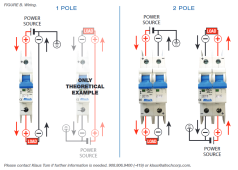I recently installed a new MPPT solar controller in my RV. While I was researching new SCC I stumbled upon a couple web sites talking about the proper way to switch solar panels on and off using a DC circuit breaker. So I ordered this one from AMAZON:
https://www.amazon.com/gp/product/B096315TSJ/ref=ppx_yo_dt_b_asin_title_o07_s01?ie=UTF8&th=1
DC Miniature Circuit Breaker, 2 Pole 1000V 63 Amp Isolator for Solar PV System, Thermal Magnetic Trip, DIN Rail Mount, Chtaixi DC Disconnect Switch C63"
I'm seeing where some DC circuit breakers have the leads switched on bottom and top....+ on the left on top and + on the right on bottom, and opposite for -.
This circuit breaker only calls out +/- on one end......There are no markings on the other end.
If you look at the attached link, there is some type of schematic on the front calling out 1,2,3,4....I'm not sure what this means.
I have it connected + to + and - to - running straight through the breaker..... Is this correct or am I going to burn my RV to the ground?
Three 140w / 12V panels in parallel.....with 4g wire of 25' to SCC



